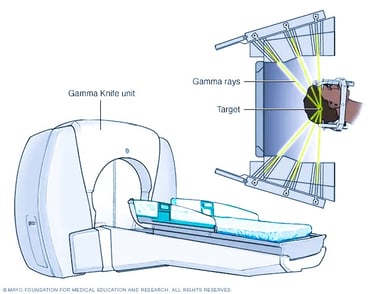What is Stereotactic Radiosurgery (SRS)? Benefits, Procedure & Risks Explained
Stereotactic Radiosurgery (SRS) is a non-invasive treatment using focused radiation to treat brain tumors and abnormalities with precision. Learn its benefits, risks, and how it works.


Introduction: Understanding Stereotactic Radiosurgery
Stereotactic Radiosurgery (SRS) is a cutting-edge medical procedure that precisely targets tumors, lesions, or vascular malformations using high doses of focused radiation. Despite the name, SRS is not a traditional surgical procedure—it’s a non-invasive treatment that eliminates the need for incisions or anesthesia. The goal of stereotactic radiosurgery is to destroy abnormal tissue while minimizing damage to surrounding healthy cells, offering patients a safer and faster recovery alternative to conventional surgery.
SRS relies on advanced imaging techniques such as CT (Computed Tomography) and MRI (Magnetic Resonance Imaging) to accurately map the tumor’s exact location, shape, and size. A specialized stereotactic frame or mask ensures patient stability and precision throughout the treatment. This high level of accuracy enables doctors to deliver intense radiation doses directly to the tumor in fewer sessions compared to standard radiation therapy.
Conditions Treated with Stereotactic Radiosurgery
Stereotactic Radiosurgery is primarily used for treating various brain disorders and tumors, including:
Brain tumors such as meningiomas, acoustic neuromas, and metastatic lesions
Arteriovenous malformations (AVMs) – abnormal tangles of blood vessels
Certain functional disorders, such as trigeminal neuralgia
Unlike open surgery, which involves physically removing tissue, SRS works by damaging the DNA of targeted abnormal cells, causing them to stop growing and eventually die over time. This process helps control the disease with minimal side effects and shorter recovery time.
Benefits of Stereotactic Radiosurgery (SRS)
Stereotactic Radiosurgery offers several major advantages that make it a preferred treatment choice in modern medical practice:
1. Non-Invasive and Painless Procedure
Unlike traditional surgery, SRS does not require incisions or anesthesia. It’s performed as an outpatient treatment, allowing most patients to go home the same day.
2. Exceptional Precision
With the help of MRI and CT imaging, SRS delivers highly targeted radiation to the tumor while preserving nearby healthy tissue. This reduces the risk of complications and enhances treatment outcomes.
3. Faster Recovery and Minimal Downtime
Patients typically experience quick recovery, resuming normal activities within 24 hours. The lack of surgical wounds significantly reduces the risk of infection or scarring.
4. Reduced Risk of Complications
SRS minimizes trauma, blood loss, and postoperative pain. This is especially beneficial for elderly patients or those with pre-existing medical conditions that make traditional surgery risky.
5. Proven Effectiveness
Studies show that stereotactic radiosurgery achieves excellent tumor control rates, especially for small to medium-sized lesions in sensitive areas like the brain.
Drawbacks and Limitations of Stereotactic Radiosurgery
While stereotactic radiosurgery has many benefits, it’s important to understand its limitations:
1. Potential Side Effects
Patients may experience temporary fatigue, headaches, or localized swelling after treatment. Although these side effects are usually mild, they can affect short-term quality of life.
2. Risk of Tumor Recurrence
In some cases, especially with aggressive or large tumors, SRS may not completely eliminate all abnormal cells, requiring additional treatments or monitoring.
3. Limited Eligibility
Not all patients are suitable candidates for SRS. Factors such as tumor size, location, and type can restrict its effectiveness. Tumors located near critical brain structures may not be ideal for this treatment.
4. High Cost of Treatment
The advanced technology and specialized equipment used in SRS make it an expensive procedure. Depending on insurance coverage, patients may face high out-of-pocket expenses.
Conclusion: Is Stereotactic Radiosurgery Right for You?
In summary, Stereotactic Radiosurgery (SRS) represents a major advancement in medical technology, offering precision, safety, and faster recovery compared to conventional surgery. It is especially beneficial for patients with brain tumors or vascular abnormalities who wish to avoid invasive operations.
However, SRS is not suitable for every case. Factors such as the size, type, and location of the tumor, as well as the patient’s overall health, play a critical role in determining eligibility. Therefore, the decision to undergo stereotactic radiosurgery should always be made in consultation with an experienced medical specialist who can evaluate all available treatment options.
As imaging and radiation technologies continue to evolve, SRS is expected to become even safer and more effective, improving outcomes and quality of life for countless patients worldwide.
